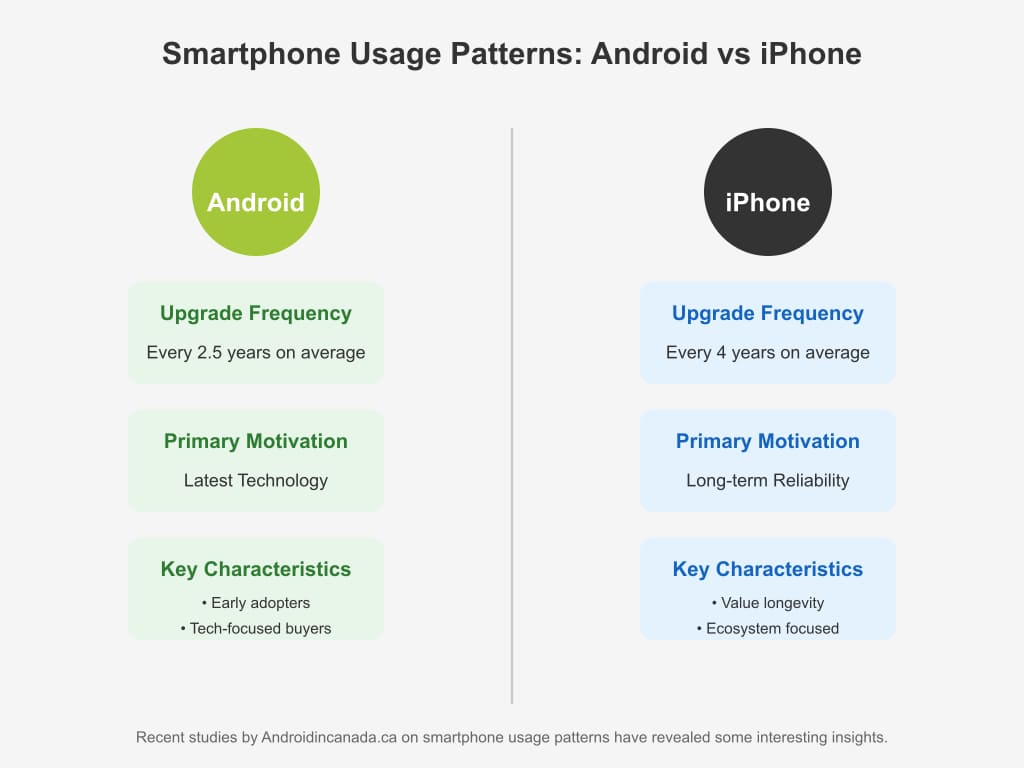The Growing Divide: Smartphone Retention Patterns Between iPhone and Android Users
A noteworthy trend has emerged in the smartphone market, underscoring pronounced disparities in the length of time users retain their devices based on their operating system preferences. Recent data from the CIRP (Consumer Intelligence Research Partners) reveals a notable disparity between iPhone and Android users’ device retention habits, with Apple users showing an increasing tendency to retain their devices for extended periods.
Smartphone Upgrade Patterns Reveal Stark User Differences
There’s a big difference in how people use smartphones, depending on whether they use Android or iPhone. Android users often upgrade, while iPhone users tend to stick with their phones longer.
Recent market analysis shows this contrast. Only one in five Android users keeps their device for more than three years. Most upgrade within two years. This shows how quickly Android devices are changing. Many companies make Android devices, and they compete with each other to make new features and offer good prices.
In contrast, iPhone users are much more loyal to their phones. A third of them keep their phones for three years or longer. Apple’s focus on longevity, strong ecosystem integration, and consistent software support for older devices contributes to this extended usage pattern.
These different behaviors show that consumers have different preferences and that the two platforms have different approaches. Android is all about choice and innovation, while Apple is focused on sustainability and long-term value.
iPhone Users Embracing Longer Device Lifecycles
The latest statistical data illustrate a compelling trend: approximately one-third of iPhone owners who purchased new devices in 2024 had retained their previous phones for a period of three years or longer. This represents an increase from the 2023 figures, which indicated that 29% of users retained their devices for the same duration. This trend indicates an increasing acceptance among iPhone users of longer device lifecycles.
Several factors contribute to this phenomenon:
- Apple’s Design Philosophy: The company’s focus on long-term device sustainability and incremental improvements rather than radical changes encourages users to keep their phones longer.
- Ecosystem Integration: Apple’s tightly integrated ecosystem of services and products creates a stable, familiar environment that reduces the urgency to upgrade.
- Financial Considerations: With Apple’s installment-based financing options, users can spread out payments over longer periods, reducing the pressure to upgrade frequently.
Android Users: A Different Approach
In contrast, Android users demonstrate markedly different behavior patterns:
- Only 21% of Android users retain their phones for three years or longer
- A substantial 57% of Android devices are replaced before reaching their second year of use
- The turnover rate is significantly higher compared to iPhone users
This accelerated upgrade cycle can be attributed to several key factors:
- Market Diversity: The Android ecosystem offers a vast array of devices across different price points, making upgrades more accessible and tempting.
- Competitive Innovation: Multiple manufacturers constantly introduce new features and technologies, creating more frequent opportunities for meaningful upgrades.
- Price Point Strategy: The availability of mid-range and budget options makes frequent upgrades more financially feasible for Android users.
Impact on the Smartphone Industry
This divergence in user behavior has significant implications for the smartphone market:
- Environmental Considerations: Longer device retention by iPhone users potentially contributes to reduced electronic waste
- Manufacturing Strategies: These patterns influence how manufacturers approach device development and marketing
- Market Dynamics: The different upgrade cycles affect how companies plan their product releases and pricing strategies
Looking Ahead
As the importance of sustainability grows and technology advances, it is possible that these retention patterns may undergo a transformation. Manufacturers on both sides of the ecosystem will be required to strike a balance between innovation and sustainability, which may result in the emergence of novel approaches to the marketing and sale of smartphones to consumers.
The current trends indicate that while iPhone users are adopting a pattern of longer-term device ownership, Android users continue to embrace the diversity and frequent innovation cycles of their chosen ecosystem. This fundamental distinction in user behavior is likely to persist, influencing the trajectory of the smartphone market.
